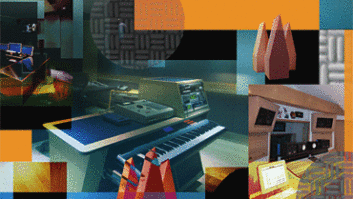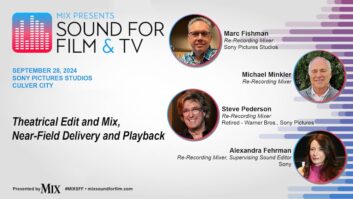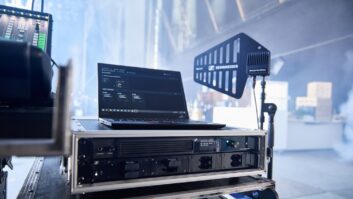
NTI’s Acoustilyzer is a remarkably powerful acoustic measurement tool in the company’s handheld “Lyzer” package. Not only is it a stand-alone unit, but current MiniLyzer owners can “cross-grade” their firmware so that MiniLyzer or Acoustilyzer software can run on their existing MiniLyzer hardware.
Using the included test signal CD or other signal source, the AL1 performs FFT or true RTA (octave or third-octave) spectrum analysis with enough resolution to get a basic sense of, for example, a room’s curve to see if it’s bass-deficient or has a midrange spike.
When greater detail is required, the Zoom FFT function narrows the bandwidth to as fine as 0.7 Hz. Input filters include FLAT, A-weighted, C-weighted, X-CRV and HP400. To facilitate the documentation process, the included MiniLINK USB interface software allows PC remote control and the ability to download displayed images and data.
Add your mic of choice (external phantom required) or use the optional $349 MiniSPL microphone (self-powered by a single AA battery), and the AL1 measures SPL, RT60 and delay, as well as long-term level (measured and logged), THD+N, level and frequency. The STI-PA Speech Intelligibility option is $798 and includes a test signal CD.
FINDING REVERB TIME
My first outing with the AL1 was testing RT60, which is particularly helpful in finding resonance. “RT” refers to reverberation time; specifically, the time required for a 60dB decrease of the initial SPL measured in five 1-octave bands from 125 Hz to 4 kHz. The test signal comprises pink noise bursts at intervals of one, two, five and 10 seconds (on and off) to accommodate various room sizes — from closet to auditorium. The goal is to get all five octaves to decay at a similar rate. To achieve this, it might require acoustic treatment (minimum) or physical alterations (maximum).
Measuring RT60 is very simple. The AL1 is first calibrated to the ambient noise level. This part can make you a little nuts if you are waiting for a plane to pass over, or for a fridge or air conditioner to complete a cycle. Pink noise is then applied at 85dB SPL. The AL1 is “armed,” and when muted, the data collection process begins.
Once armed, I left the room to minimize false data. The AL1 tells you when the data is not valid. Individual tests can be viewed and deleted if flawed, increasing the accuracy of the averaged data. Each band’s decay time is displayed and can be stored locally (including a text data file) or transferred to a computer. Remember, images require more memory than data. I measured my control room and performance space and each were pretty well-balanced: Short times for the former and longer times for the latter.
ZOOMING IN
As mentioned, NTI has significantly enhanced the spectral capabilities by adding the Zoom FFT feature. For example, when analyzing the response of a pair of speakers in a space, it is necessary to first precisely center the microphone. This can only be done on an analyzer with sufficient resolution — which is now possible with Zoom FFT — allowing the user to see the effect of comb filtering.
The outcome of this test should result in precise centering of the speakers, ensuring that the sound from each arrives at the monitoring position at the same time. Choosing remote-control operation (via USB) rather than pushing buttons that might disturb the AL1’s position further enhances the accuracy of the procedure.
The best example of this test was performed at MasterMix Studios (Minneapolis). KRK mains were mounted in the control room wall. Once the monitors’ center was found, I switched to each of the alternate near-field monitors — Genelec, ProAc and Yamahas — re-centering them to be in line with the mains. This was a piece of cake for the AL1, eliminating the need for rooster-like “head shifting” when trying to relocate the center.
Taking delay time measurements requires playing a signal from the CD into the AL1. Then, while that same signal is played through the system, the user can measure and store delay times from multiple listening points.
CAN YOU HEAR ME NOW?
Intelligibility is becoming an increasingly important issue. Consider the typically high levels of background noise in public spaces combined with an aging population that is gradually losing its hearing capabilities. Improving P.A. systems and their environments is a dirty job, but someone has to do it.
With the test signal originating in my living room, I went into other rooms for the test. STI-PA scrutinizes six frequency bands — compared to the RT60’s five bands — with the presence region from 4 kHz to 8 kHz playing an essential role in my ability to discern the more delicate aspects of speech. The AL1 tells the user how much trouble it had trying to discern the test signal. All in all, my rooms were remarkably passable.
DOES IT PASS THE TEST?
The Acoustilyzer’s strength is in its high power-to-size ratio. It may not be as powerful as some software packages, but it is less cumbersome than a laptop and assorted accessories (mic, preamp, converter). And at $904 for the basic AL1, it’s affordable. With a little explanation, you’ll be able to show customers that their room problem is not in their heads but is actually measurable.
NTI-Americas, 503/639-3737, www.nt-instruments.com.






